formerly eScholarship Editions


|
|
|
|
Browse by Title
All Titles | Public Titles
A | B | C | D | E | F | G | H | I | J | K | L | M | N | O | P | Q | R | S | T | U | V | W | Y | Z | OTHERYour request for titles beginning with B found 100 book(s). | Modify Search | Displaying 81 - 100 of 100 book(s) | |
| 81. | 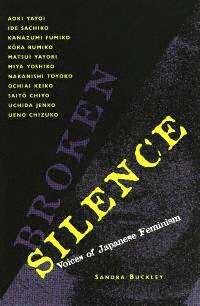 | Title: Broken silence: voices of Japanese feminism Author: Buckley, Sandra 1954- Published: University of California Press, 1997 Subjects: Asian Studies | Japan | Gender Studies | Women's Studies | Politics | Sociology Publisher's Description: Broken Silence brings together for the first time many of Japan's leading feminists, women who have been bucking the social mores of a patriarchal society for years but who remain virtually unknown outside Japan. While Japan is often thought to be without a significant feminist presence, these interviews and essays reveal a vital community of women fighting for social change.Sandra Buckley's dialogues with poets, journalists, teachers, activists, and businesswomen exemplify the diversity of Japanese feminism: we meet Kanazumi Fumiko, a lawyer who assists women in a legal system that has long discriminated against them; Kora Rumiko, a poet who reclaims and redefines language to convey her experiences as a woman; Nakanishi Toyoko, founder of the Japanese Women's Bookstore; and Ueno Chizuko, a professor who has tackled such issues as pornography and abortion reform both in and out of the academy.These women speak to a host of issues - the politics of language, the treatment of women in medicine and law, the deeply entrenched role of women as mothers and caregivers, the future of feminism in Japan, and the relationship between Japanese feminists and "western" feminisms. Broken Silence will do much to dispel Western stereotypes about Japanese women and challenge North American attitudes about feminism abroad. With a timeline, glossary, and comprehensive list of feminist organizations, this is a long overdue collection sure to inform and excite all those interested in feminism and Japan. [brief] Similar Items |
| 82. | 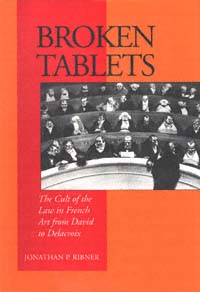 | Title: Broken tablets: the cult of the law in French art from David to Delacroix Author: Ribner, Jonathan P Published: University of California Press, 1993 Subjects: Art | Art History | French Studies | European Literature | European History | Law Publisher's Description: In this first study of art, law, and the legislator, Jonathan Ribner provides a revealing look at French art from 1789 to 1848, the period in which constitutional law was established in France. Drawing on several disciplines, he discusses how each of the early constitutional regimes in France used imagery suggesting the divine origin and sacred character of its laws.Primarily a study of art and politics, Broken Tablets discusses painting, sculpture, prints, and medals (many reproduced here for the first time), as well as contemporary literature, including the poetry of Alfred de Vigny, Alphonse de Lamartine, and Victor Hugo. Ribner assesses the ways in which legislation imagery became an instrument of political propaganda, and he clearly illuminates the cult of the law as it became personalized under Napoleon, monarchist under the Restoration, and defensive under Louis-Phillipe. [brief] Similar Items |
| 83. |  | Title: Bronzino's Chapel of Eleonora in the Palazzo Vecchio Author: Cox-Rearick, Janet Published: University of California Press, 1993 Subjects: Art | Art History Publisher's Description: Do the sacred decorations of a Florentine Renaissance chapel - saints, symbols, and scriptural stories - hold personal and political meanings? Cox-Rearick's ground-breaking book explores the message hidden in the frescoes and altar panels of the Chapel of Eleonora di Toledo, painted in the early 1540s by Agnolo Bronzino for the Spanish-born wife of Duke Cosimo I de Medici. Bronzino, then the chief painter to the Medici court, was largely responsible for the invention in Florence of the highly self-conscious, elegant Maniera style. Cox-Rearick interweaves her account of the Medici biography with an examination of Bronzino's commission in the broader context of his oeuvre.Cox-Rearick reveals the Chapel of Eleonora as an intimately devised decorative program that transmits messages about its patrons and Medici rule. Detailed color photographs of the newly restored art splendidly document this early tour de force of a major artist whose works are still relatively unexamined. [brief] Similar Items |
| 84. | 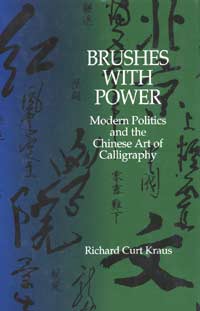 | Title: Brushes with power: modern politics and the Chinese art of calligraphy Author: Kraus, Richard Curt Published: University of California Press, 1991 Subjects: Politics | China | Art Publisher's Description: Chinese calligraphy has traditionally been an emblem of the ruling class and its authority. After a century of mass revolution, what is the fate of this elite art? Richard Kraus explores the relationship beween politics and the art of writing in China today to explicate the complex relationship between tradition and modernity in Chinese culture. His study draws upon a wide range of sources, from political documents, memoirs, and interviews with Chinese intellectuals to art exhibitions and television melodramas.Mao Zedong and other Communist leaders gave calligraphy a revolutionary role, believing that their beloved art reflected the luster of authoritative words and deeds. Calligraphy was joined with new propagandistic mass media to become less a private art and more a public performance. It provided politically engaged citizens with subtle cues to changing power relationships in the People's Republic.Claiming neither that the Communists obliterated traditional culture nor that revolution failed to relieve the burden of China's past, this study subtly examines the changing uses of tradition in a modernizing society. [brief] Similar Items |
| 85. |  | Title: A buccaneer's atlas: Basil Ringrose's South Sea waggoner: a sea atlas and sailing directions of the Pacific coast of the Americas, 1682 Author: Ringrose, Basil d. 1686 Published: University of California Press, 1992 Subjects: History | Renaissance History | European History | Geography Publisher's Description: On July 29, 1681, a band of English buccaneers that had been terrorizing Spanish possessions on the west coast of the Americas captured a Spanish ship, from which they obtained a derrotero , or book of charts and sailing directions. When they arrived back in England, the Spanish ambassador demanded that the buccaneers be brought to trial. The derrotero was ordered to be brought to King Charles II, who apparently appreciated its great intelligence value. The buccaneers were acquitted, to the chagrin of the king of Spain, who had the English ambassador expelled from the court at Madrid on a seemingly trumped-up charge.The derrotero was subsequently translated, and one of the buccaneers, Basil Ringrose, added a text to the compilation and information to the Spanish charts. The resulting atlas, consisting of 106 pages of charts and 106 pages of text, is published in full for the first time in this volume. Covering the coast from California to Tierra del Fuego, the Galapagos, and Juan Fernandes, Basil Ringrose's south sea waggoner is a rich source of geographical information, with observations on navigational, physical, biological, and cultural features as well as on ethnography, customs, and folklore.After almost exactly three hundred years, this secret atlas is now made available to libraries and individuals. The editors have provided an extensive introduction on historical, geographical, and navigational aspects of the atlas, as well as annotations to the charts and text, and they have plotted the coverage of the charts on modern map bases. [brief] Similar Items |
| 86. | 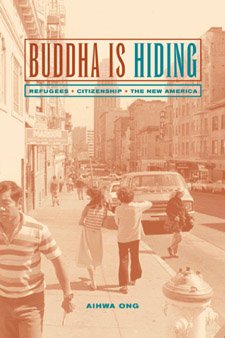 | Title: Buddha is hiding: refugees, citizenship, the new America Author: Ong, Aihwa Published: University of California Press, 2003 Subjects: Anthropology | American Studies | Asian American Studies | Gender Studies | Urban Studies | Sociology | Immigration Publisher's Description: Fleeing the murderous Pol Pot regime, Cambodian refugees arrive in America as at once the victims and the heroes of America's misadventures in Southeast Asia; and their encounters with American citizenship are contradictory as well. Service providers, bureaucrats, and employers exhort them to be self-reliant, individualistic, and free, even as the system and the culture constrain them within terms of ethnicity, race, and class. Buddha Is Hiding tells the story of Cambodian Americans experiencing American citizenship from the bottom-up. Based on extensive fieldwork in Oakland and San Francisco, the study puts a human face on how American institutions - of health, welfare, law, police, church, and industry - affect minority citizens as they negotiate American culture and re-interpret the American dream. In her earlier book, Flexible Citizenship, anthropologist Aihwa Ong wrote of elite Asians shuttling across the Pacific. This parallel study tells the very different story of "the other Asians" whose route takes them from refugee camps to California's inner-city and high-tech enclaves. In Buddha Is Hiding we see these refugees becoming new citizen-subjects through a dual process of being-made and self-making, balancing religious salvation and entrepreneurial values as they endure and undermine, absorb and deflect conflicting lessons about welfare, work, medicine, gender, parenting, and mass culture. Trying to hold on to the values of family and home culture, Cambodian Americans nonetheless often feel that "Buddha is hiding." Tracing the entangled paths of poor and rich Asians in the American nation, Ong raises new questions about the form and meaning of citizenship in an era of globalization. [brief] Similar Items |
| 87. | 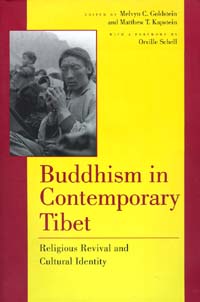 | Title: Buddhism in contemporary Tibet: religious revival and cultural identity Author: Goldstein, Melvyn C Published: University of California Press, 1998 Subjects: Religion | Cultural Anthropology | Tibet | Buddhism Publisher's Description: Following the upheavals of the Cultural Revolution, the People's Republic of China gradually permitted the renewal of religious activity. Tibetans, whose traditional religious and cultural institutions had been decimated during the preceding two decades, took advantage of the decisions of 1978 to begin a Buddhist renewal that is one of the most extensive and dramatic examples of religious revitalization in contemporary China. The nature of that revival is the focus of this book. Four leading specialists in Tibetan anthropology and religion conducted case studies in the Tibet autonomous region and among the Tibetans of Sichuan and Qinghai provinces. There they observed the revival of the Buddhist heritage in monastic communities and among laypersons at popular pilgrimages and festivals. Demonstrating how that revival must contend with tensions between the Chinese state and aspirations for greater Tibetan autonomy, the authors discuss ways that Tibetan Buddhists are restructuring their religion through a complex process of social, political, and economic adaptation. Buddhism has long been the main source of Tibetans' pride in their culture and country. These essays reveal the vibrancy of that ancient religion in contemporary Tibet and also the problems that religion and Tibetan culture in general are facing in a radically altered world. [brief] Similar Items |
| 88. | 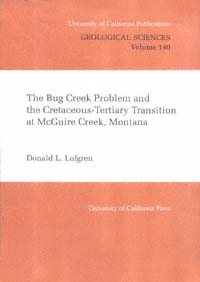 | Title: The Bug Creek problem and the Cretaceous-Tertiary transition at McGuire Creek, Montana Author: Lofgren, Donald L 1950- Published: University of California Press, 1995 Subjects: Science | Paleontology Publisher's Description: Bug Creek assemblages from Montana, transitional in composition between typical Cretaceous and Paleocene vertebrate faunas, are critical to K-T extinction debates because they have been used to support both gradual and catastrophic K-T extinction scenarios. Geological and palynological data from McGuire Creek indicate that Bug Creek assemblages are Paleocene and restricted to channel fills entrenched into older sediments, suggesting that the Cretaceous component of the assemblage was reworked. Thus, the author concludes, "Paleocene dinosaurs" are an illusion and the K-T survival rate of mammals is low because the presence of Cretaceous mammals in Bug Creek assemblages is also the result of reworking. [brief] Similar Items |
| 89. | 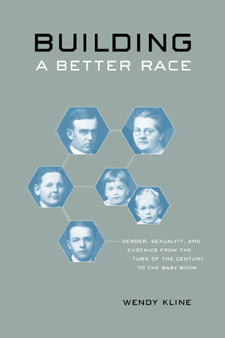 | Title: Building a better race: gender, sexuality, and eugenics from the turn of the century to the baby boom Author: Kline, Wendy 1968- Published: University of California Press, 2001 Subjects: History | United States History | Gender Studies | American Studies | History and Philosophy of Science Publisher's Description: Wendy Kline's lucid cultural history of eugenics in America emphasizes the movement's central, continuing interaction with popular notions of gender and morality. Kline shows how eugenics could seem a viable solution to problems of moral disorder and sexuality, especially female sexuality, during the first half of the twentieth century. Its appeal to social conscience and shared desires to strengthen the family and civilization sparked widespread public as well as scientific interest. Kline traces this growing public interest by looking at a variety of sources, including the astonishing "morality masque" that climaxed the 1915 Panama Pacific International Exposition; the nationwide correspondence of the influential Human Betterment Foundation in Pasadena, California; the medical and patient records of a "model" state institution that sterilized thousands of allegedly feebleminded women in California between 1900 and 1960; the surprising political and popular support for sterilization that survived initial interest in, and then disassociation from, Nazi eugenics policies; and a widely publicized court case in 1936 involving the sterilization of a wealthy young woman deemed unworthy by her mother of having children. Kline's engaging account reflects the shift from "negative eugenics" (preventing procreation of the "unfit") to "positive eugenics," which encouraged procreation of the "fit," and it reveals that the "golden age" of eugenics actually occurred long after most historians claim the movement had vanished. The middle-class "passion for parenthood" in the '50s had its roots, she finds, in the positive eugenics campaign of the '30s and '40s. Many issues that originated in the eugenics movement remain controversial today, such as the use of IQ testing, the medical ethics of sterilization, the moral and legal implications of cloning and genetic screening, and even the debate on family values of the 1990s. Building a Better Race not only places eugenics at the center of modern reevaluations of female sexuality and morality but also acknowledges eugenics as an essential aspect of major social and cultural movements in the twentieth century. [brief] Similar Items |
| 90. | 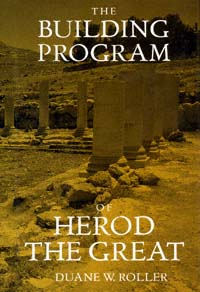 | Title: The building program of Herod the Great Author: Roller, Duane W Published: University of California Press, 1998 Subjects: Classics | Architecture | Ancient History | Archaeology Publisher's Description: Herod the Great, King of Judaea from 444 B.C., is known as one of the world's great villains. This notoriety has overshadowed his actual achievements, particularly his role as a client king of Rome during Augustus's reign as emperor. An essential aspect of Herod's responsibilities as king of Judaea was his role as a builder. Remarkably innovative, he created an astonishing record of architectural achievement, not only in Judaea but also throughout Greece and the Roman east. Duane W. Roller systematically presents and discusses all the building projects known to have been initiated by Herod, and locates this material in a broad historical and cultural context.Bringing together previously inaccessible material, Roller enriches our understanding of the enigmatic Herod and provides new insights into Roman architecture. Herod was instrumental in the diffusion of the Augustan architectural revolution into the provinces and was the first to build outside Italy such Italian architectural forms as the basilica, amphitheater, villa, and Italian temple. Herod's legacy provided a groundwork for the architectural Romanization of the east, influencing the construction of the great temple complexes and palaces so familiar from later Roman architecture.Herod, like Augustus himself, was not only interested in architecture but also in diplomatic and financial contacts among cities of the region. In addition to providing a repertorium of the building projects, this study is also an exploration of international relations in the eastern Mediterranean at the beginning of the Roman imperial period. [brief] Similar Items |
| 91. | 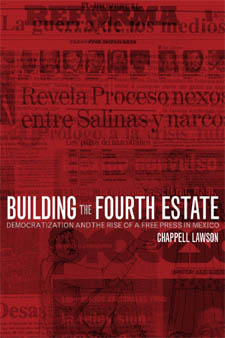 | Title: Building the fourth estate: democratization and the rise of a free press in Mexico Author: Lawson, Chappell H 1967- Published: University of California Press, 2002 Subjects: Politics | Latin American Studies | Media Studies Publisher's Description: Based on an in-depth examination of Mexico's print and broadcast media over the last twenty-five years, this book is the most richly detailed account available of the role of the media in democratization, demonstrating the reciprocal relationship between changes in the press and changes in the political system. In addition to illuminating the nature of political change in Mexico, this accessibly written study also has broad implications for understanding the role of the mass media in democratization around the world. [brief] Similar Items |
| 92. | 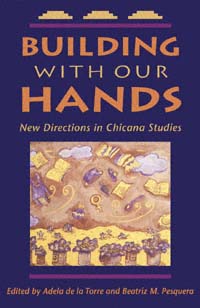 | Title: Building with our hands: new directions in Chicana studies Author: Torre, Adela de la Published: University of California Press, 1993 Subjects: Ethnic Studies | Latin American Studies | Latino Studies | Sociology | Gender Studies | Chicano Studies Publisher's Description: This is the first interdisciplinary collection of articles addressing the unique history of Chicana women. From a diverse range of perspectives, a new generation of Chicana scholars here chronicles the previously undocumented rich tapestry of Chicanas' lives over the last three centuries. Focusing on how women have grappled with political subordination and sexual exploitation, the contributors confront the complex intersection of class, race, ethnicity, and gender that defines the Chicana experience in America.The book analyzes the ways that oppressive power relations and resistance to domination have shaped Chicana history, exploring subjects as diverse as sexual violence against Amerindian women during the Spanish conquest of California to contemporary Chicanas' efforts to construct feminist cultural discourses.The volume ends with a provocative dialogue among the contributors about the challenges, frustrations, and obstacles that face Chicana scholars, and the voices heard here testify to the vibrant state of Chicano scholarship.Trenchant and wide-ranging, this collection is essential reading for understanding the dynamics of feminism and multiculturalism. [brief] Similar Items |
| 93. | 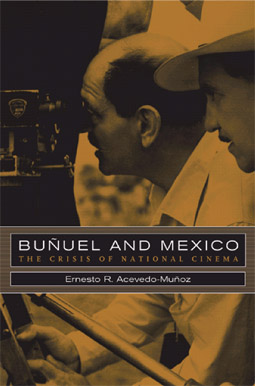 | Title: Buñuel and Mexico: the crisis of national cinema Author: Acevedo-Muñoz, Ernesto R 1968- Published: University of California Press, 2003 Subjects: Cinema and Performance Arts | Latin American History | Latin American Studies Publisher's Description: Though Luis Buñuel, one of the most important filmmakers of the twentieth century, spent his most productive years as a director in Mexico, film histories and criticism invariably pay little attention to his work during this period. The only English-language study of Buñuel's Mexican films, this book is the first to explore a significant but neglected area of this filmmaker's distinguished career and thus to fill a gap in our appreciation and understanding of both Buñuel's achievement and the history of Mexican film. Ernesto Acevedo-Muñoz considers Buñuel's Mexican films - made between 1947 and 1965 - within the context of a national and nationalist film industry, comparing the filmmaker's employment of styles, genres, character types, themes, and techniques to those most characteristic of Mexican cinema. In this study Buñuel's films emerge as a link between the Classical Mexican cinema of the 1930s through the 1950s and the "new" Cinema of the 1960s, flourishing in a time of crisis for the national film industry and introducing some of the stylistic and conceptual changes that would revitalize Mexican cinema. [brief] Similar Items |
| 94. | 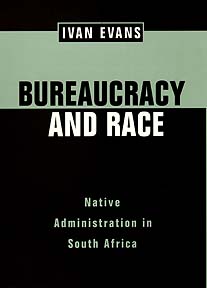 | Title: Bureaucracy and race: native administration in South Africa Author: Evans, Ivan Thomas 1957- Published: University of California Press, 1997 Subjects: African Studies | African History | Sociology | Postcolonial Studies | Cultural Anthropology Publisher's Description: Bureaucracy and Race overturns the common assumption that apartheid in South Africa was enforced only through terror and coercion. Without understating the role of violent intervention, Ivan Evans shows that apartheid was sustained by a great and ever-swelling bureaucracy. The Department of Native Affairs (DNA), which had dwindled during the last years of the segregation regime, unexpectedly revived and became the arrogant, authoritarian fortress of apartheid after 1948. The DNA was a major player in the prolonged exclusion of Africans from citizenship and the establishment of a racially repressive labor market. Exploring the connections between racial domination and bureaucratic growth in South Africa, Evans points out that the DNA's transformation of oppression into "civil administration" institutionalized and, for whites, legitimized a vast, coercive bureaucratic culture, which ensnared millions of Africans in its workings and corrupted the entire state. Evans focuses on certain features of apartheid - the pass system, the "racialization of space" in urban areas, and the cooptation of African chiefs in the Bantustans - in order to make it clear that the state's relentless administration, not its overtly repressive institutions, was the most distinctive feature of South Africa in the 1950s. All observers of South Africa past and present and of totalitarian states in general will follow with interest the story of how the Department of Native Affairs was crucial in transforming "the idea of apartheid" into a persuasive - and all too durable - practice. [brief] Similar Items |
| 95. | 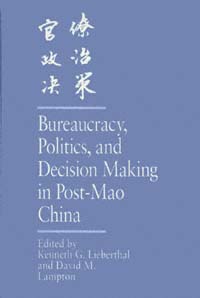 | Title: Bureaucracy, politics, and decision making in post-Mao China Author: Lieberthal, Kenneth Published: University of California Press, 1992 Subjects: Politics | China Publisher's Description: Using a model of "fragmented authoritarianism," this volume sharpens our view of the inner workings of the Chinese bureaucracy. The contributors' interviews with politically well-placed bureaucrats and scholars, along with documentary and field research, illuminate the bargaining and maneuvering amo . . . [more] Similar Items |
| 96. | 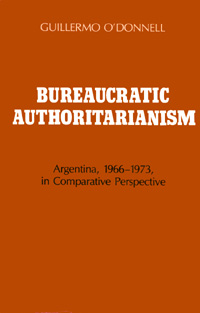 | Title: Bureaucratic authoritarianism: Argentina, 1966-1973, in comparative perspective Author: O'Donnell, Guillermo A Published: University of California Press, 1988 Subjects: Politics | Political Theory | Latin American Studies Similar Items |
| 97. | 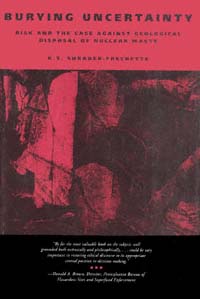 | Title: Burying uncertainty: risk and the case against geological disposal of nuclear waste Author: Shrader-Frechette, K. S. (Kristin Sharon) Published: University of California Press, 1993 Subjects: Science | Ecology | Public Policy Publisher's Description: Shrader-Frechette looks at current U.S. government policy regarding the nation's high-level radioactive waste both scientifically and ethically.What should be done with our nation's high-level radioactive waste, which will remain hazardous for thousands of years? This is one of the most pressing problems faced by the nuclear power industry, and current U.S. government policy is to bury "radwastes" in specially designed deep repositories.K. S. Shrader-Frechette argues that this policy is profoundly misguided on both scientific and ethical grounds. Scientifically - because we cannot trust the precision of 10,000-year predictions that promise containment of the waste. Ethically - because geological disposal ignores the rights of present and future generations to equal treatment, due process, and free informed consent.Shrader-Frechette focuses her argument on the world's first proposed high-level radioactive waste facility at Yucca Mountain, Nevada. Analyzing a mass of technical literature, she demonstrates the weaknesses in the professional risk-assessors' arguments that claim the site is sufficiently safe for such a plan. We should postpone the question of geological disposal for at least a century and use monitored, retrievable, above-ground storage of the waste until then. Her message regarding radwaste is clear: what you can't see can hurt you. [brief] Similar Items |
| 98. | 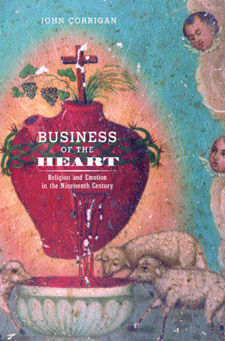 | Title: Business of the heart: religion and emotion in the nineteenth century Author: Corrigan, John 1952- Published: University of California Press, 2001 Subjects: Religion | American Studies | United States History | Christianity Publisher's Description: The "Businessmen's Revival" was a religious revival that unfolded in the wake of the 1857 market crash among white, middle-class Protestants. Delving into the religious history of Boston in the 1850s, John Corrigan gives an imaginative and wide-ranging interpretive study of the revival's significance. He uses it as a focal point for addressing a spectacular range of phenomena in American culture: the ecclesiastical and business history of Boston; gender roles and family life; the history of the theater and public spectacle; education; boyculture; and, especially, ideas about emotion during this period. This vividly written narrative recovers the emotional experiences of individuals from a wide array of little-used sources including diaries, correspondence, public records, and other materials. From these sources, Corrigan discovers that for these Protestants, the expression of emotion was a matter of transactions. They saw emotion as a commodity, and conceptualized relations between people, and between individuals and God, as transactions of emotion governed by contract. Religion became a business relation with God, with prayer as its legal tender. Entering this relationship, they were conducting the "business of the heart." This innovative study shows that the revival--with its commodification of emotional experience--became an occasion for white Protestants to underscore differences between themselves and others. The display of emotion was a primary indicator of membership in the Protestant majority, as much as language, skin color, or dress style. As Corrigan unravels the significance of these culturally constructed standards for emotional life, his book makes an important contribution to recent efforts to explore the links between religion and emotion, and is an important new chapter in the history of religion. [brief] Similar Items |
| 99. |  | Title: Busing and backlash: white against white in a California school district Lillian B. Rubin Author: Rubin, Lillian B Published: University of California Press, 1973 Subjects: Sociology | Urban Studies | American Studies | African American Studies Similar Items |
| 100. | 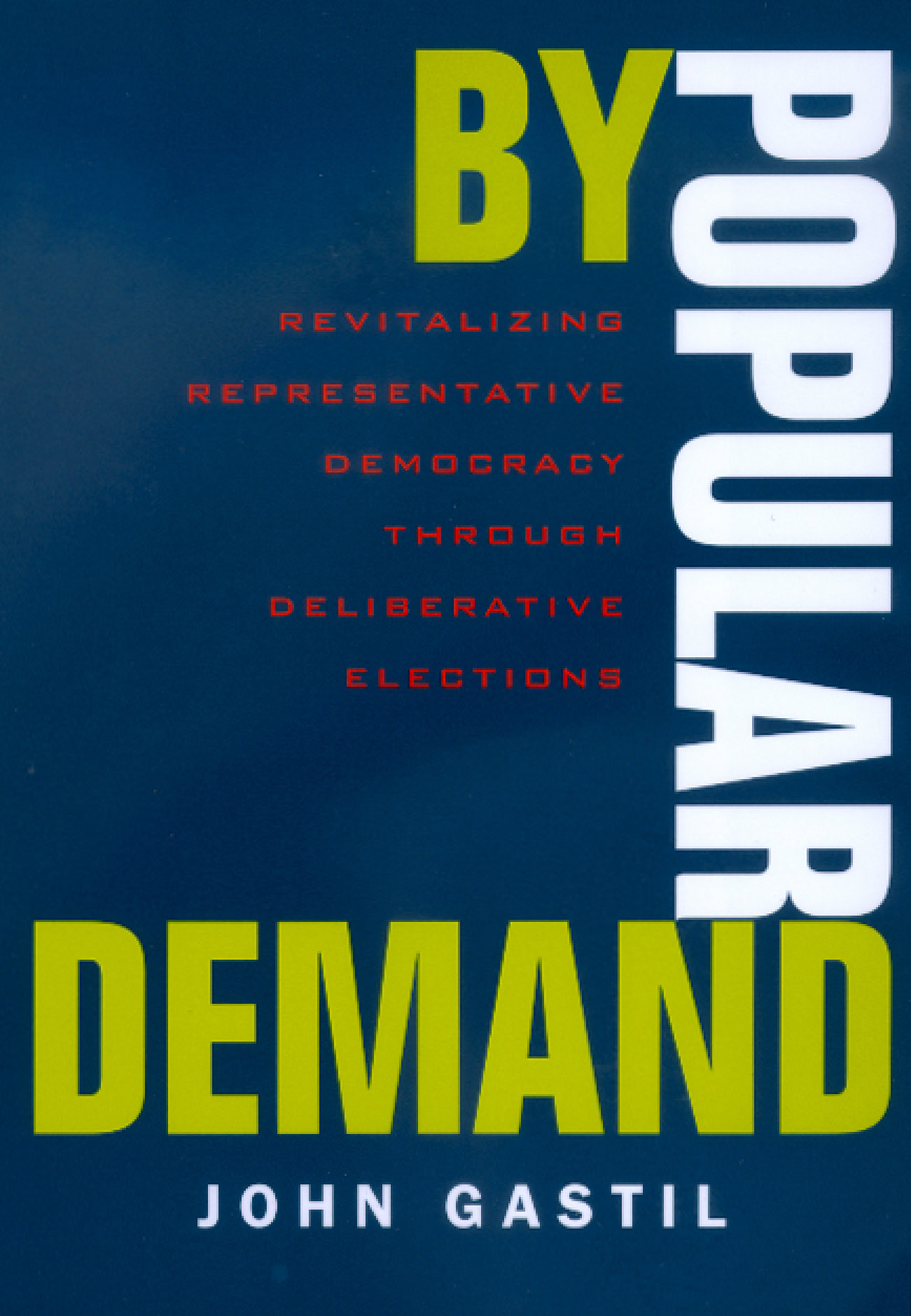 | Title: By popular demand: revitalizing representative democracy through deliberative elections Author: Gastil, John Published: University of California Press, 2000 Subjects: Politics Publisher's Description: John Gastil challenges conventional assumptions about public opinion, elections, and political expression in this persuasive treatise on how to revitalize the system of representative democracy in the United States. Gastil argues that American citizens have difficulty developing clear policy interests, seldom reject unrepresentative public officials, and lack a strong public voice. Our growing awareness of a flawed electoral system is causing increased public cynicism and apathy. The most popular reforms, however, will neither restore public trust nor improve representation. Term limits and campaign finance reforms will increase turnover, but they provide no mechanism for improved deliberation and accountability. Building on the success of citizen juries and deliberative polling, Gastil proposes improving our current process by convening randomly selected panels of citizens to deliberate for several days on ballot measures and candidates. Voters would learn about the judgments of these citizen panels through voting guides and possibly information printed on official ballots. The result would be a more representative gov-ernment and a less cynical public. America has a long history of experimentation with electoral systems, and the proposals in By Popular Demand merit serious consideration and debate. [brief] Similar Items |